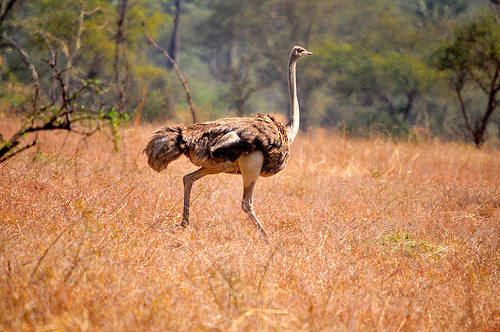Birding Safaris are very popular in the Northern part of Uganda and particularly in the Kidepo Valley National Park. Kidepo valley national park is located in the North Eastern part of Uganda, bordering Kenya and South Sudan between the hills of Karamoja and Nagoya Valley. The Park consists of shallow valley systems, with a dry mountain terrain. In the South-west is the Narus Valley, bordered by the Napore range to the north-west, South of Kidepo Valley is the Morungole range, and north is Mount Lotuke in South Sudan, Montane forest, grassy plains, open tree savannah, thick miombo-like woodlands and the rocky outcrops.
Kidepo is known for its notable birds of prey. Of these 56 species recorded, 14 including the verrueax’s eagle, Egyptian vulture and pygmy falcon are believed to be endemic to Kidepo and karamoja region. There has been no comprehensive survey of birds in Kidepo and visitors stand at good chance of adding to the current list. In Kidepo Valley National Park is the only park in Uganda where you can find the common ostrich. Ostrich eggs are harvested for breeding purposes by UWA in order to increase the number of ostriches in the park.
 Kidepo birding experience is better to begin from Apoka rest camp as it is a great spot to begin birding. Birding can also be done on the fringes of the Narus and Namamukweny Valleys. Among the birds seen are the Abyssinian Roller, Purple Heron, Abyssinian Ground Hornbill and Clapperton’s Francolin, which is found only in Kidepo. The activity can be arranged both in the morning and evening.
Kidepo birding experience is better to begin from Apoka rest camp as it is a great spot to begin birding. Birding can also be done on the fringes of the Narus and Namamukweny Valleys. Among the birds seen are the Abyssinian Roller, Purple Heron, Abyssinian Ground Hornbill and Clapperton’s Francolin, which is found only in Kidepo. The activity can be arranged both in the morning and evening.
The attractive Silverbird and small bands of Yellow-billed Shrike, frequent the thorn trees around the camp as do a number of other widespread species such as the Vinaceous Dove, Hoopoe, Nubian Woodpecker, Mosque Swallow, the Ruppell’s and Superb Starlings, Scarlet-chested Sunbird, Little Weaver and Red-cheeked Cordon-bleu. A small permanent water hole at the edge of the camp attracts swallows and a variety of seedeaters including the Yellow-rumped Seedeater and is visited at night by the Four-banded Sand grouse, Elephants, Buffaloes, and occasionally Lions. Clapperton’s Francolin, Black Coucal, African Moustached and the Broad-tailed Warblers, Marsh Tchagra and Crimson-rumped Waxbill may be seen in the rank grass along the normally dry stream bed adjacent to the camp or along the track to Apoka lodge.
The Common Ostrich, Secretary Bird, African Swallow-tailed Kite, Eastern Pale Chanting Goshawk, Pygmy Falcon, Fox Kestrel, Stone Partridge, Clapperton’s and Heuglin’s Francolins, Yellow-necked Spurfowl, Kori, White-bellied and Hartlaub’s Bustards, Violet-tipped Courser, Black-headed Plover, Four-banded Sand Grouse, Bruce’s Green Pigeon, Rose-ringed Parakeet, White-crested Turaco, White-bellied Go-away bird, White-faced Scoops Owl, Long-tailed and Standard-winged Nightjars, Little Green Bee-eater, Abyssinian and Rufous-crowned Rollers, the Abyssinian Ground, Eastern Yellow and Jackson’s Hornbills, Red-fronted and Black-breasted Barbets, Brown-backed Woodpecker, Singing Bush lark, Red-winged Lark, Ethiopian Swallow, the Pied, Isabelline and Heuglin’s Wheaters, African Grey Flycatcher, Foxy and White-bellied Tit, Mouse-coloured Penduline Tit, Northern White-crowned and Yellow-billed Shrikes, Slate-coloured Boubou, Fan-tailed Raven, Superb Starling, Red billed Oxpecker, Eastern Violet backed, Pygmy and Beautiful Sunbirds, Rufous and Chestnut Sparrow, Yellow-spotted Petronia, White-headed and White-billed Buffalo Weavers, White-browed and Chestnut- crowned Sparrow Weavers, Grey-capped Social and Speckle-fronted Weavers, the Green-winged, Orange-winged and Red-winged Pytilias, Black-bellied and Black-faded Waxbills, Steel-blue and Straw tailed Whydahs, and the Brown-rumped Bunting, are just a few of the 480 bird species the Park boosts of. You should not afford missing taking a look at these beautiful birds.
How to get there
Kidepo Valley National Park can either be accessed by road or by air. The most usual route passes through Gulu and Kitgum ideally, one can preferably plan to stay in one of these towns.
The routes include;
Kampala-Karuma-Gulu-Kitgum-Kidepo and Kampala-Karuma-Lira-Kotido-Kaabong-Kidepo, passing via West of Lake Kyoga through Acholi land.
Kampala-Mbale-Soroti-Moroto-Kotido-Kaabong-Kidepo and Kampala-Mbale-Sironko-Moroto-Kotido-Kaabong-Kidepo, passing via East of Lake Kyoga through Karamoja.
What to bring
A round hat
Light clothing
Sun screen
Sun glasses
A flashlight with spare batteries
Camera with spare batteries
Binoculars for viewing of birds
Insect repellent
A lot of drinking water
Cotton underwear
Food if you’re to stay at rest camps

